
The Garmin Fenix 8 AMOLED is as adventurous of a watch as money can buy. It packs all the bells and whistles, including an updated display, excellent battery life, and a built-in flashlight that's handy for emergencies. Sure, you'll pay a pretty penny, but it's so worth the money.
When you see the word ultra in the name of, well, anything, you attach a particular set of expectations. You expect whatever it is to go above and beyond an average threshold and enter into some form of rarified air. The Galaxy S24 Ultra, for example, packs more cameras than any other Samsung device, and it’s the only one to come with an integrated S Pen. Another, perhaps more fitting, example is the ultramarathon — a race that’s longer (sometimes much longer) and more grueling than your standard 26.2-mile marathon. It’s with that race in mind that the Ultra moniker made its way to top-end smartwatches from both Apple and Samsung, promising the ability to do more and last longer for the hardest of adventures.
And it’s true — the Apple Watch Ultra and Galaxy Watch Ultra are the biggest, longest-lasting wearables their respective companies have ever produced. They let you go days without charging and offer a mountain of features to keep you feeling connected. However, one watch embodies the Ultra spirit better than any other, and it does so without even mentioning the name. In my opinion, the best ultra watch that money can buy (because, yes, it’s quite pricey) is the Garmin Fenix 8 AMOLED.
Ready for anything (and anyone)
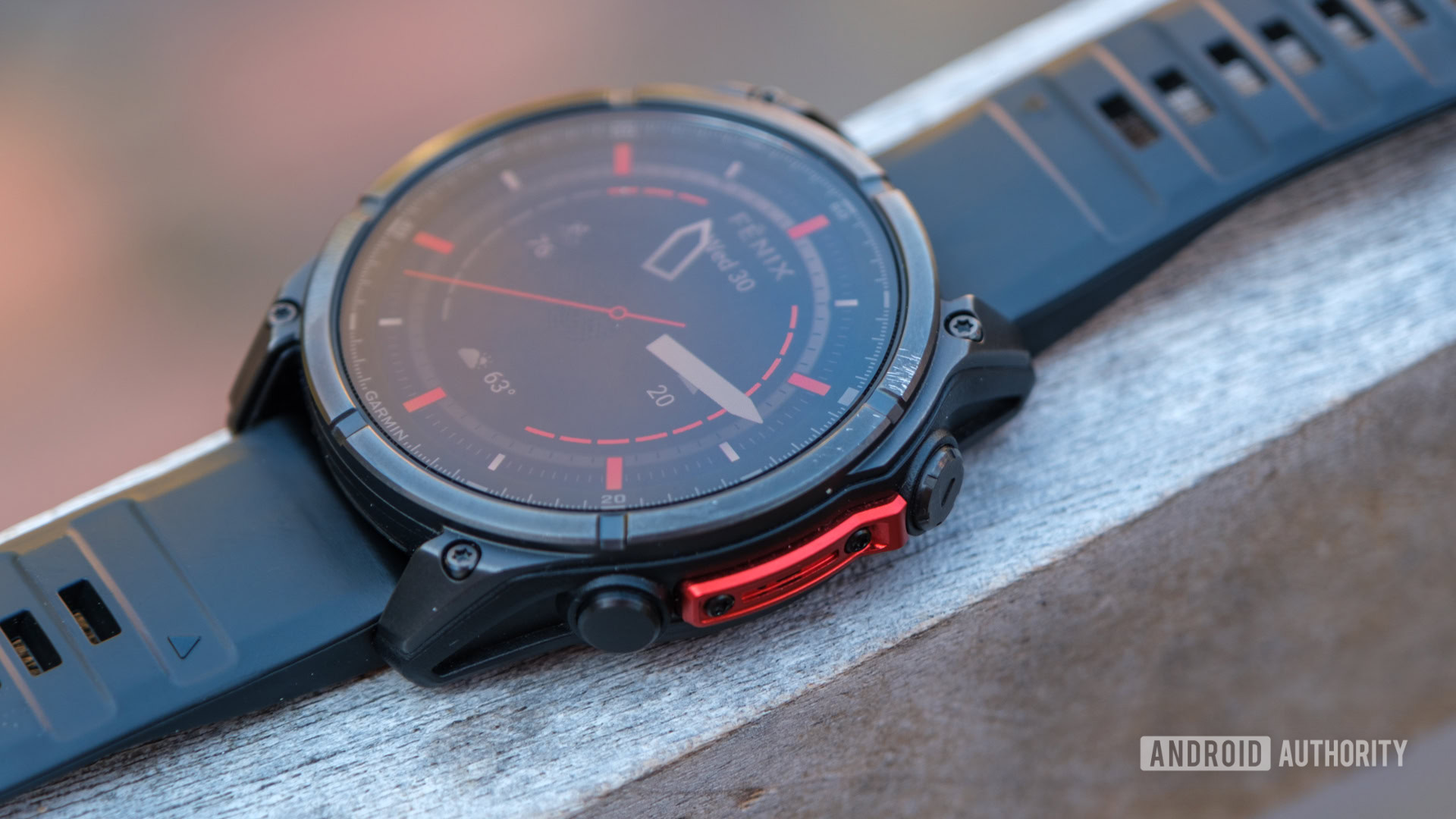
Ryan Haines / Android Authority
When you think about the Galaxy Watch Ultra or the Apple Watch Ultra, one thing probably comes to mind — the rugged designs. Both watches offer a who’s who of durability features, from the titanium frames to the sapphire glass faces, and both come with reliable IP ratings for good measure. However, it doesn’t always feel like you can separate them from the everyday Galaxy Watch and Apple Watch they’re based on.
Garmin’s Fenix 8 AMOLED, on the other hand, approaches durability from the opposite side. Rather than spring for the toughest materials across the board, it acts more like it’s descended from years of adventure watch experience — mainly because it is. It’s like the perfect combination of the road-ready Forerunner 965 with my beloved Epix Pro 2, and it feels just right. Yes, the Fenix 8 AMOLED comes with a chunky bezel (made of either stainless steel or titanium) for protection, and yes, you can grab a version with a durable sapphire glass face, but neither feature feels like a must-have because the rest of the watch feels so locked-down and durable.
Honestly, I kind of appreciate the reinforced polymer case, as it doesn’t ring out with a metallic clang every time I hit it on something — which happens a lot. Garmin’s stainless steel bezel can also attest to my clumsiness since its Slate Gray finish has a few telltale scuffs from when I wore it to my local bouldering gym. There’s no actual damage to the watch, just a few flecks of shiny steel that show through as if to prove I’m using the Fenix 8 AMOLED the way it was meant to be used.
Sapphire glass and titanium are optional, but the Fenix 8 AMOLED doesn't seem to need either one.
Moving on, we can’t explore Garmin’s latest edition of the Fenix without mentioning its main upgrade: the optional AMOLED face. It’s still not a standard feature across the entire lineup, but I’ve become somewhat spoiled by Garmin’s bright, crisp panel since I first used it on the Forerunner 265. Garmin used its new display as justification to introduce a whole new slate of animations, making everything from your Body Battery readout to the awards that pop up when you finish your fastest mile or longest run look just a bit more lively, and I don’t see myself going back to the older, simpler Memory in Pixel (MIP) animations any time soon.
Granted, there are probably a few battery truthers out there who would happily point out that MIP displays don’t use as much power, and maybe they’re right. However, the Fenix 8 AMOLED already boasts more than two weeks of juice between charges (more on this in a minute), so I’m perfectly happy to stick with the brighter, more exciting panel. I might feel differently about it if there were a chance I’d go weeks on end without access to a charger, but there’s not, so give me all the fun, colorful animations. Now, if only Garmin could pick up the pace with optimizing some of its best watch faces for the new panel.
Another bright spot on the Garmin Fenix 8 AMOLED — excuse the terrible pun — is the built-in LED flashlight. It’s not quite bright enough to step in for a headlamp on a nighttime run, but the two-tap activation means it’s usually faster to activate than my phone flashlight if I drop something or need to fish a toy for my cats out from under the couch. And yes, I’ve used the flashlight to read a menu at a bar, but I only did that once because it felt a little too silly.
Anyway, the real reason I think the Fenix 8 AMOLED is the best “Ultra” watch money can buy is because it’s the most flexible — and it’s not even close. It’s not picky about what phone you pair it with — mine has spent time with both my Pixel 9 Pro and iPhone 16 Pro — and it’s the only Ultra watch that lets you pick what size case you need. Unlike the Apple Watch Ultra, which comes in a single 49mm case, or the Galaxy Watch Ultra, with a single 47mm option, the Garmin Fenix 8 AMOLED offers a trio of case sizes. There’s a 43mm version for users with smaller wrists, the 47mm model I’ve been testing, and a larger 51mm option with a bigger battery and even more display real estate.
I don’t think I could ever use the larger Fenix 8 — even the 47mm version feels a little too big for me at times — but I have to give Garmin credit for its flexibility. I know that I’m built differently from some of my closest friends who are also runners, and some of Garmin’s elite ultrarunning athletes are a different breed entirely, yet there’s a version of the Fenix 8 that could work for any of us.
Can you hear me now?
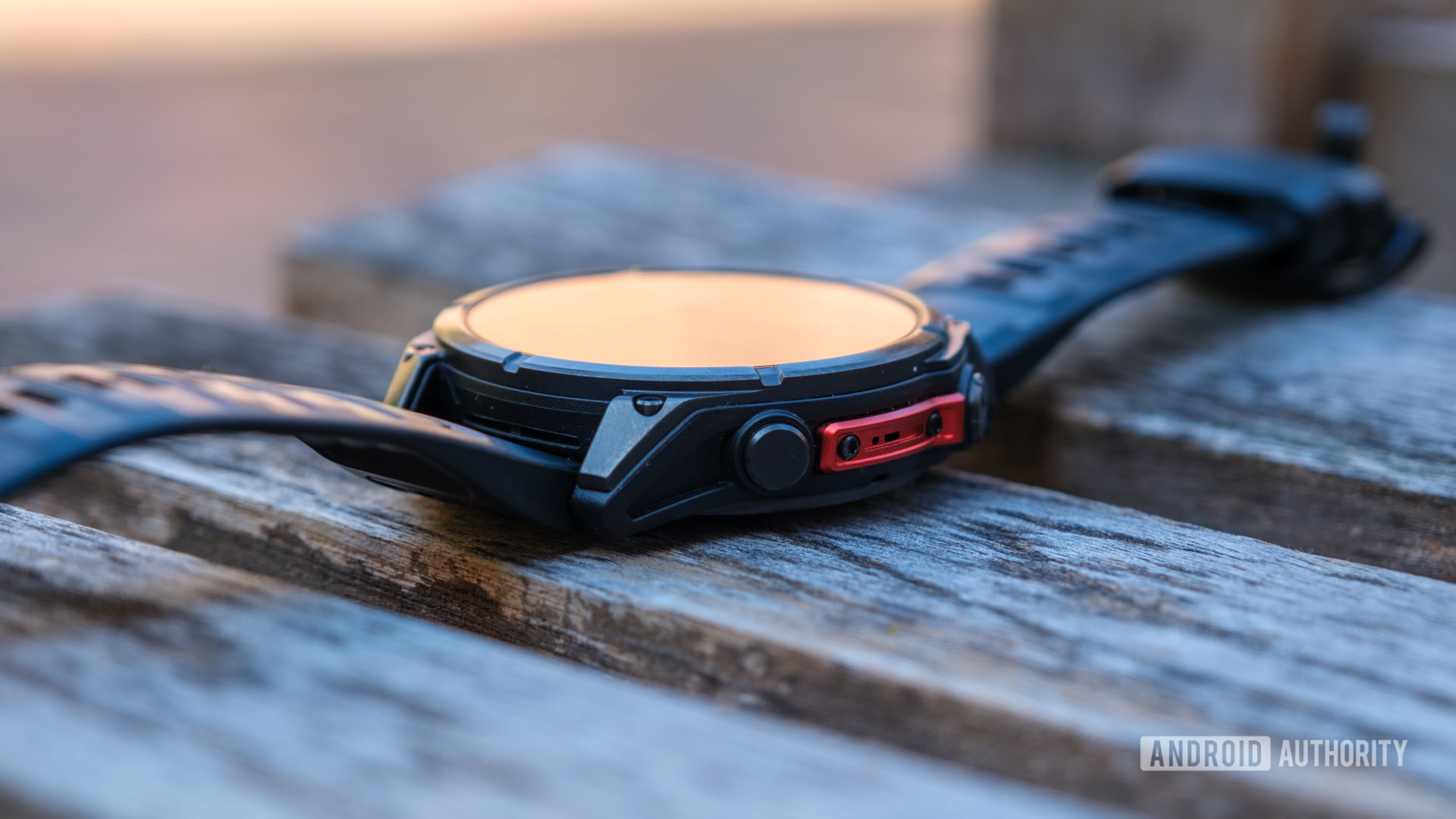
Ryan Haines / Android Authority
While I’ve usually been pretty enthusiastic about my experiences with Garmin GPS watches, I’ve always run into a bit of a hiccup when it comes to the actual smartwatch features. See, although I don’t personally care about being able to respond to a text from my wrist (thanks, fat fingers), I know that there are people who do, which is reason enough for them to reach for a Galaxy Watch or a comparable Apple Watch. Now, the Fenix 8 AMOLED shifts that balance a little more in its favor — even if it doesn’t flip things entirely.
The bad news is that you still can’t respond to a text message from your wrist, at least not in the traditional “open a keyboard and type” way. However, you can respond to those messages via voice command because the Fenix 8 AMOLED finally has a microphone mounted on the side of its case. With that microphone comes support for voice assistants and the ability to take calls right from your wrist — a feature that caught me off guard at first.
The punchy speaker and sharp microphone make the Fenix 8 AMOLED feel much more like a smartwatch.
See, I’m used to pressing the buttons on my watch to accept or reject a call and then grabbing my phone to start the conversation. This time, when I went to answer a FaceTime call using my Fenix 8 AMOLED, I heard my friends’ voices erupting from my wrist. It was, of course, a FaceTime call, so using my wrist only covered about half of what I needed, but I quickly realized that I could do the same for standard calls, opening up a whole new avenue of communication — or eliminating running as an excuse for ignoring a phone call. Either way, the microphone brings the Fenix 8 AMOLED a step closer to competing with traditional Ultra smartwatches, and I’m here for it.
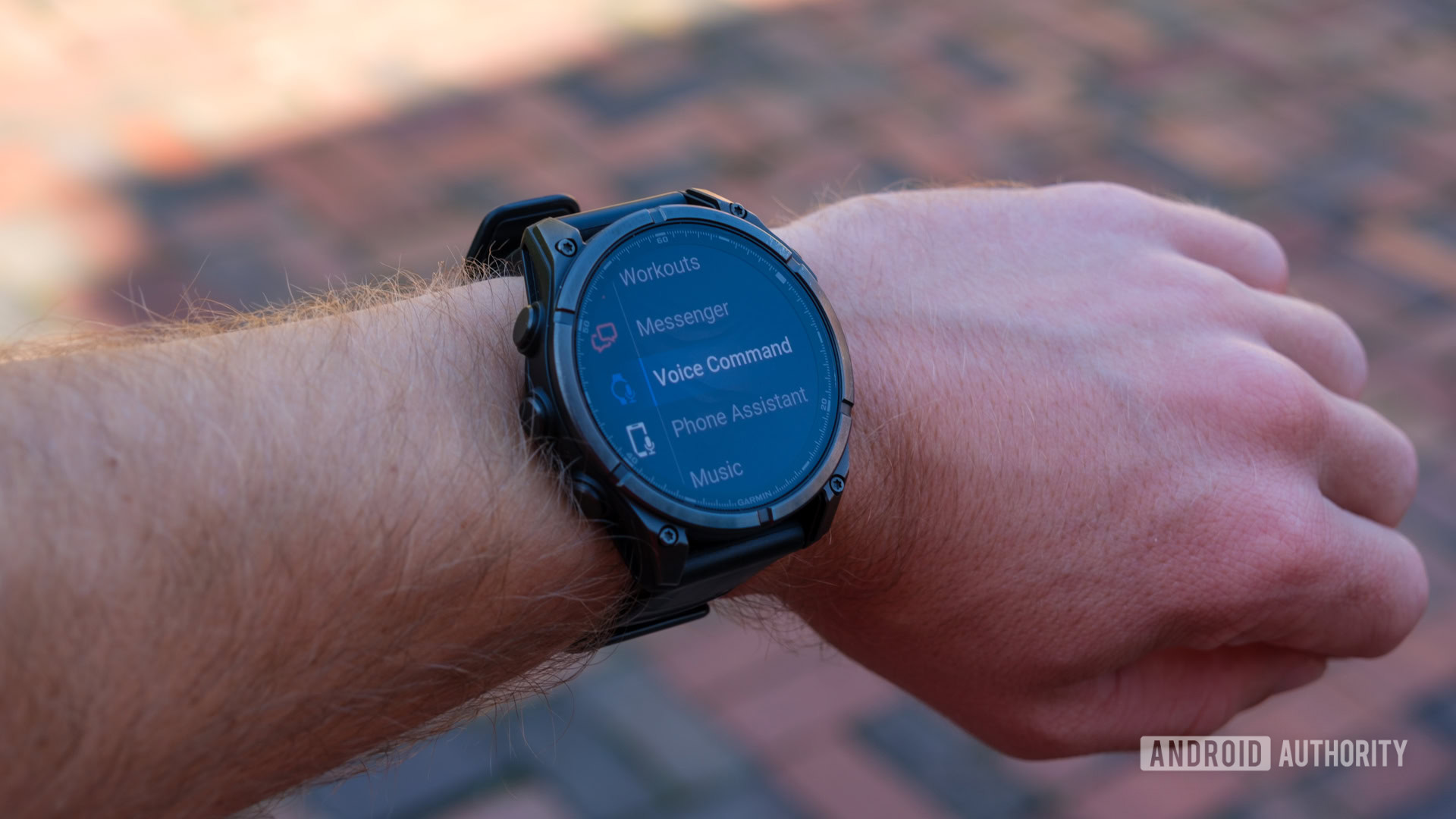
Ryan Haines / Android Authority
Along with that microphone, the Fenix 8 AMOLED packs a brand-new speaker, which you might have expected me to touch on in the design section above. After all, it’s another fairly standard trait among ultra-tier wearables. However, I’m slotting it here because the new speaker has all-new sound effects. Everything sounds deeper and richer, from the chime when you pick up a GPS signal to the voice that announces your mile splits throughout a workout. Previously, I would have equated Garmin’s notification chimes to those on a Nothing Phone — kind of harsh and screechy — so I’ll take the new, deeper sounds any day.
Outside of the microphone and speaker upgrades, the rest of Garmin’s smartwatch-esque features remain mostly rock-solid. I continue to rely heavily on Garmin Pay when I’m out for a long run and decide to stop for coffee, and I’m glad to have a full-color weather map at my disposal, even though I’m going outside for a run, no matter the conditions. If you’re the type to listen to music while you work out, the Fenix 8 AMOLED packs a solid 32GB of storage, which is more than enough for a few playlists that you can manage from your wrist — just keep in mind that extra Bluetooth usage on top of GPS tracking might do a number on your battery life.
The heart of an adventurer
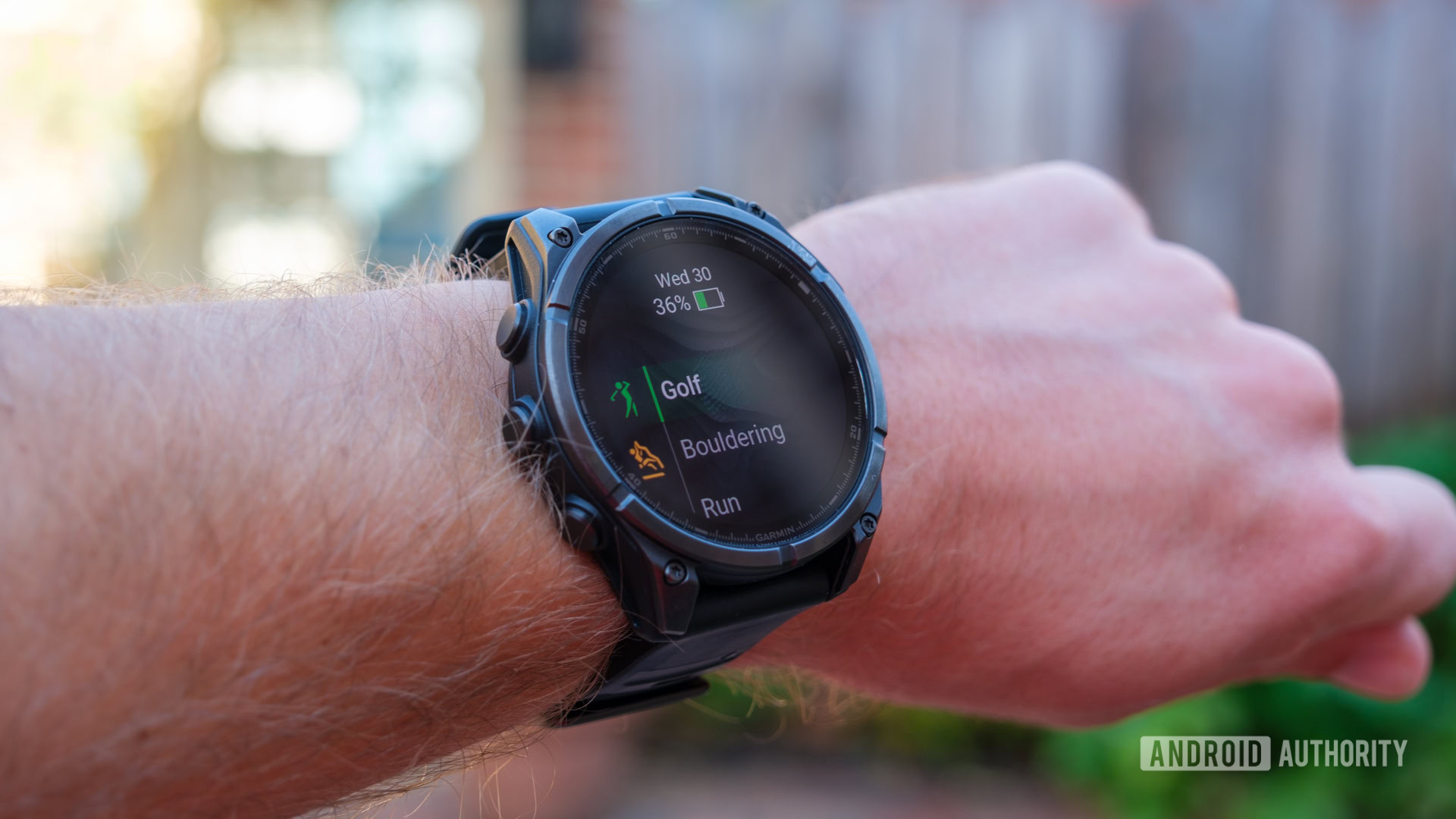
Ryan Haines / Android Authority
Although a rugged design is usually a dead giveaway for an ultra-grade watch, and smartwatch-like features go a long way in establishing some quality of life, what matters most is how your wearable can handle the adventures you seek. More than supporting a ton of activity types (which the Fenix 8 AMOLED does), it means holding enough juice to carry you through a busy week of activity tracking. And, with a fall schedule that consisted of a weekly recreational soccer game on Monday nights, five days of marathon training per week, and an expensive climbing gym membership that I continue to try to justify, I figured I’d see just how much adventure the watch could handle.
Long story short — it can handle just about everything I could come up with. I’ve had the Fenix 8 AMOLED on my wrist for a little more than a month at this point, and I’ve put it through a few different workouts of everything mentioned above, and it hasn’t blinked once. Not all of the workouts are worth sharing — bouldering, for example, only tracks the difficulty of each climb, my heart rate, and the time it took — but I’ve logged enough of them to have a pretty good feel for the Fenix 8’s heart rate and GPS accuracy.
The Fenix 8 AMOLED is ready for any activity, including a few dozen that you'll probably never use.
Before we get to my activities, though, I should probably touch on the latest version of Garmin’s sleep tracking. Outside of a few shiny new animations in the Morning Report, it hasn’t changed from what I was used to on the Epix Pro 2. Garmin still monitors your HRV status, can automatically detect naps (if you manage to sleep during the day), and offers a sleep coach to analyze your nightly rest and provide insights on your sleep quality. Mine has been somewhat of a mess since I returned from Europe, but I’ve slowly been returning to normal — just in time for daylight savings to start. Anyway, back to the more interesting metrics.
Of the bunch, the workout that best demonstrates what the Fenix 8 AMOLED can do is a 5K that I raced in the build-up to running the Amsterdam Marathon. Feeling adventurous, I decided to swap the race for one of my more casual Saturday runs, but I didn’t want to sacrifice my weekly mileage. So, I worked it out in my head that I could jog to the start, run a hard 5K, and then jog home afterward — three separate efforts that would put the Fenix 8 under different levels of stress. There’s almost nothing exciting to mention about the runs there or back (other than the fact that Garmin’s Resume Later option is a lifesaver when it comes to preserving my battery), but the accuracy of the dual-band GPS during the race impressed me.
I’m not usually one to take on a 5K (I prefer longer distances), but the race offered a chance to loop through Baltimore’s football and baseball stadiums without worrying about crowds, so how could I pass that up? Anyway, if you’ve ever been in or around a stadium, you know that they don’t make GPS tracking very easy. Something about the dense concrete and high stands makes it challenging to get a reliable lock on your location, which tends to throw off the pacing on your watch. It’s the same idea as running a marathon through a crowded city like Chicago — you end up trusting the crowd rather than the watch you’ve used for months.
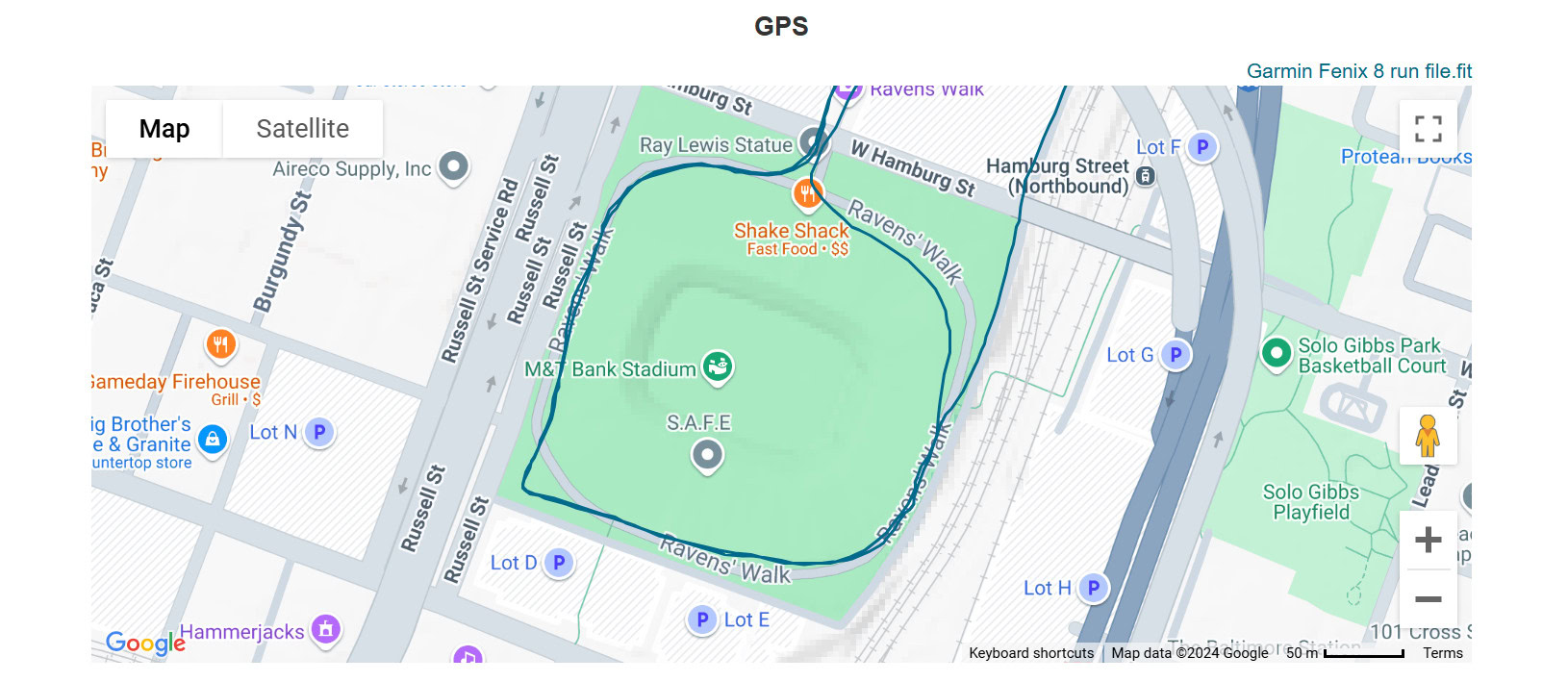
Ryan Haines / Android Authority
So, imagine my surprise when I finished the race (which involved two tight loops around M&T Bank Stadium) and went to check out the map of my run. I figured there might be a few wobbles to the track as I went around the concourse, but I couldn’t have been more wrong. The Fenix 8 AMOLED nailed both laps, hugging closer to the stadium on my first loop but pushing the second loop a bit wider to account for the slower joggers and the families with strollers that I had to pass to finish.
I also took a quick look at a few of the Fenix 8 AMOLED’s other metrics, like my heart rate and my average speed, just to see if I could pick out which part of each measurement matched different segments of the race. At first, I was slightly concerned by the two matching drops in pace — downward spikes that almost resemble a vampire’s fangs — until I realized that they matched a point in my loop around the stadium where I had to make a practically hairpin-sharp turn. There was no drop in heart rate to match those breaks, but I didn’t expect one, given how short the turn was. The Fenix 8 AMOLED also uses the same Elevate Gen 5 heart rate sensor that the previous Fenix 7 Pro and Epix Pro 2 used, so it boasts similar accuracy to some of the watches I already trust.
With Garmin’s GPS and heart rate prowess established, you might wonder about the battery life you can expect from the Fenix 8 AMOLED. Well, I’d say it’s certainly deserving of the Ultra name. Garmin claims that you can reach up to 16 days of battery life from the 47mm version, and I’d agree with that assessment. As I said, I’ve had my Fenix 8 for about a month now, and I’ve only had to charge it twice — once after about a week because it came with less than a full charge and a second time just before I headed to Europe for a week of vacation. If you need even more juice, Garmin claims you can get 29 days of usage out of the 51mm Fenix 8, but I still don’t think I’d want something that large on my wrist.
Unfortunately, one drawback to the Fenix 8 AMOLED’s charging setup is that I’m still tired of proprietary cables. Yes, it’s good that Garmin still includes one in the box, and I’m glad it switched to USB-C cables about a year ago, but I don’t love that I have to travel with an extra charger whenever I have battery anxiety. Thankfully, I can usually remember to top up my charge before I go on most trips, but I also know I probably won’t find someone with a Garmin charger should worse come to worse.
Garmin Fenix 8 AMOLED review: An Ultra smartwatch without the Ultra name
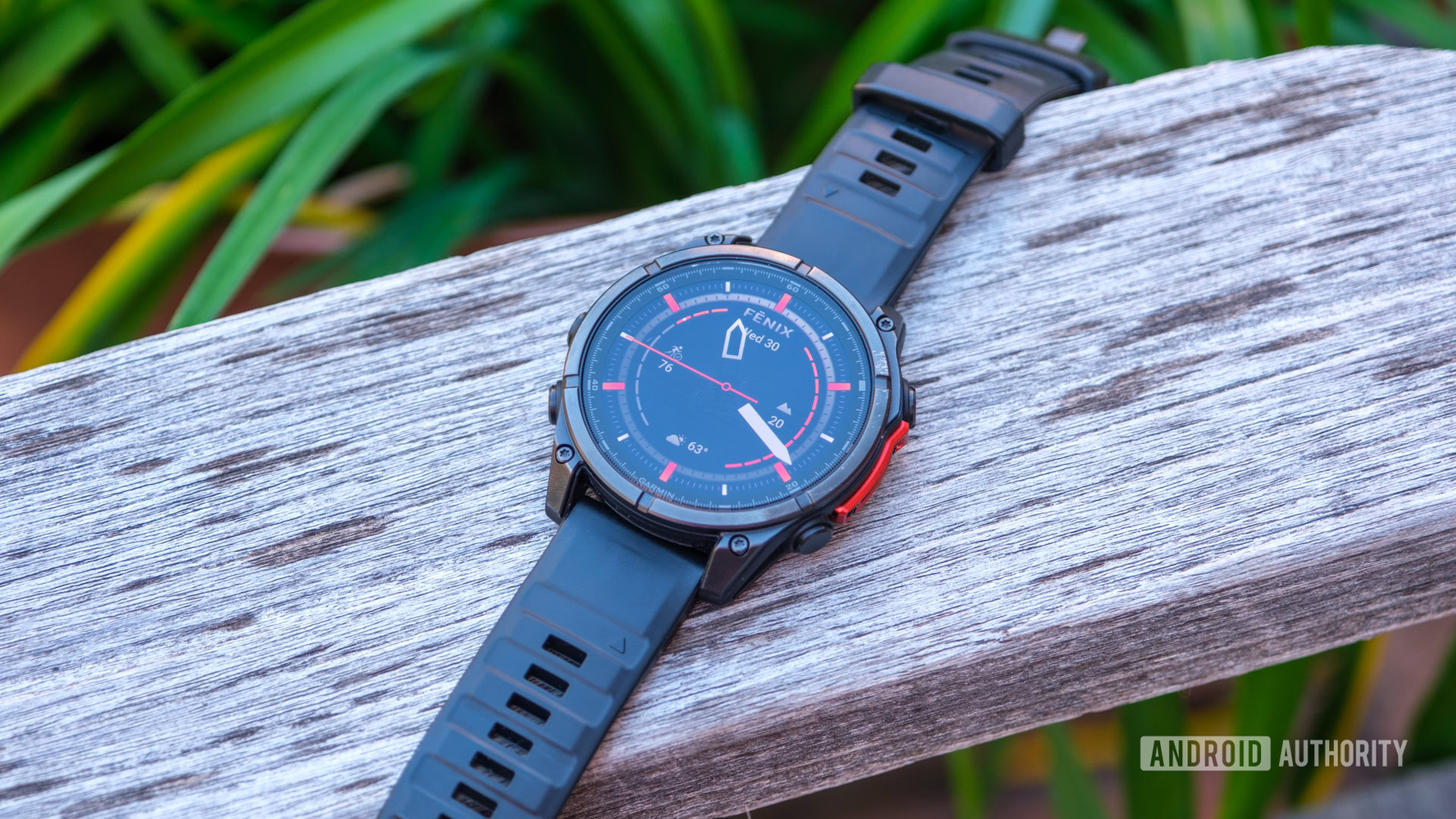
Ryan Haines / Android Authority
At the end of the day, I don’t know how you can ask for more from your watch than the Garmin Fenix 8 AMOLED can provide. Maybe you want the ability to type on your watch, or perhaps you’d like support for a few more apps, but I don’t think you can find a wearable that’s more prepared for an adventure. There are still features that I’m stumbling upon with the Fenix 8 AMOLED, simply because I didn’t know to look for them. I didn’t know to look for Garmin’s Jet Lag Adviser until after I got back from Europe, but my sleep schedule probably would have thanked me had I found it sooner — at least as long as it could account for post-marathon fatigue, too.
However, that’s an excellent way to sum up what sets the Fenix 8 AMOLED apart from other ultra-tier watches on the market. Whereas the Samsung Galaxy Watch Ultra and Apple Watch Ultra feel like extensions of their everyday counterparts, Garmin’s latest flagship is all adventure, all the time. What it lacks in app support, it more than makes up for in battery life, operating system flexibility, and overall durability. No, you won’t be able to open up Strava on your watch to deal kudos while you wait for the sun to rise, but you’ll be able to use your LED flashlight to navigate past poison ivy and other hazards when nature calls.
Maybe it's not a smartwatch like Apple or Samsung would make, but the Fenix 8 AMOLED is an adventure watch that only Garmin could come up with.
In my eyes, that’s what an adventure watch should be — it should make life easier while you’re off the grid, but it doesn’t have to act like an extension of your smartphone while doing so. If I’m out for a hike, a trail run, or another flavor of Type B fun, I’d much rather stay focused on my experience than worry about whatever notifications my phone wants to share with me.
And yet, I know that some people will take one look at the Garmin Fenix 8 AMOLED and go right back to their Apple Watch Ultra ($759.99 at eBay) or Galaxy Watch Ultra ($649.99 at Amazon). I know that the Fenix 8 AMOLED is the most expensive of the three — by a decent margin — and doesn’t offer exclusive features like Apple and Samsung’s top-end wearables do. If you’re a dedicated iPhone user, you’ll probably gravitate toward the Apple Watch Ultra’s seamless integration with Siri or the Walkie-Talkie mode that only works with other Apple Watches. You’ll probably love the same square interface that every Apple Watch has used since the start, and you’ll happily build up a new collection of bands for the extra-large connectors.
Likewise, Galaxy users will probably reach for Samsung’s first attempt at an Ultra watch. Maybe the squircle design reminds me too much of an Apple Watch, but that’s what happens when Apple has a little more practice with its design. If not the Galaxy Watch Ultra, you might even go for the slightly older Galaxy Watch 5 Pro, which offers a tighter mix of adventurous features while still looking like a watch you can wear every day.
There’s nothing wrong with any of those options — all three are reliable watches in their own right — but if you’re in for an adventure, I think the Garmin Fenix 8 AMOLED is the best watch to guide you along the way.


Garmin Fenix 8 AMOLED
Bright built-in flashlight • Excellent battery life • Sharp AMOLED face
Ready for adventure.
The Fenix 8 AMOLED is an ultra-tier smartwatch in everything but name, with a plethora of features for adventurers, incredible durability, and excellent battery life.

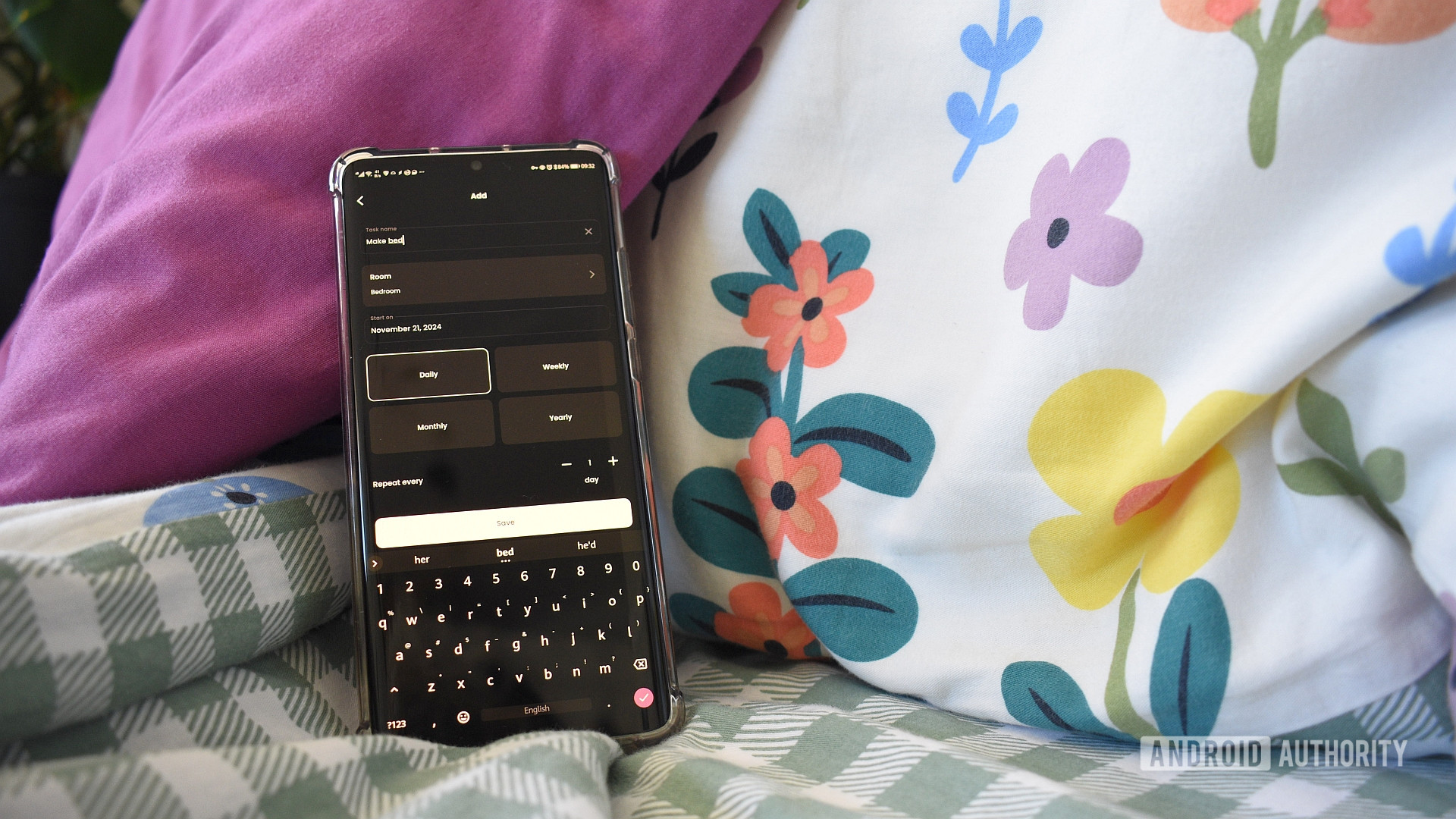
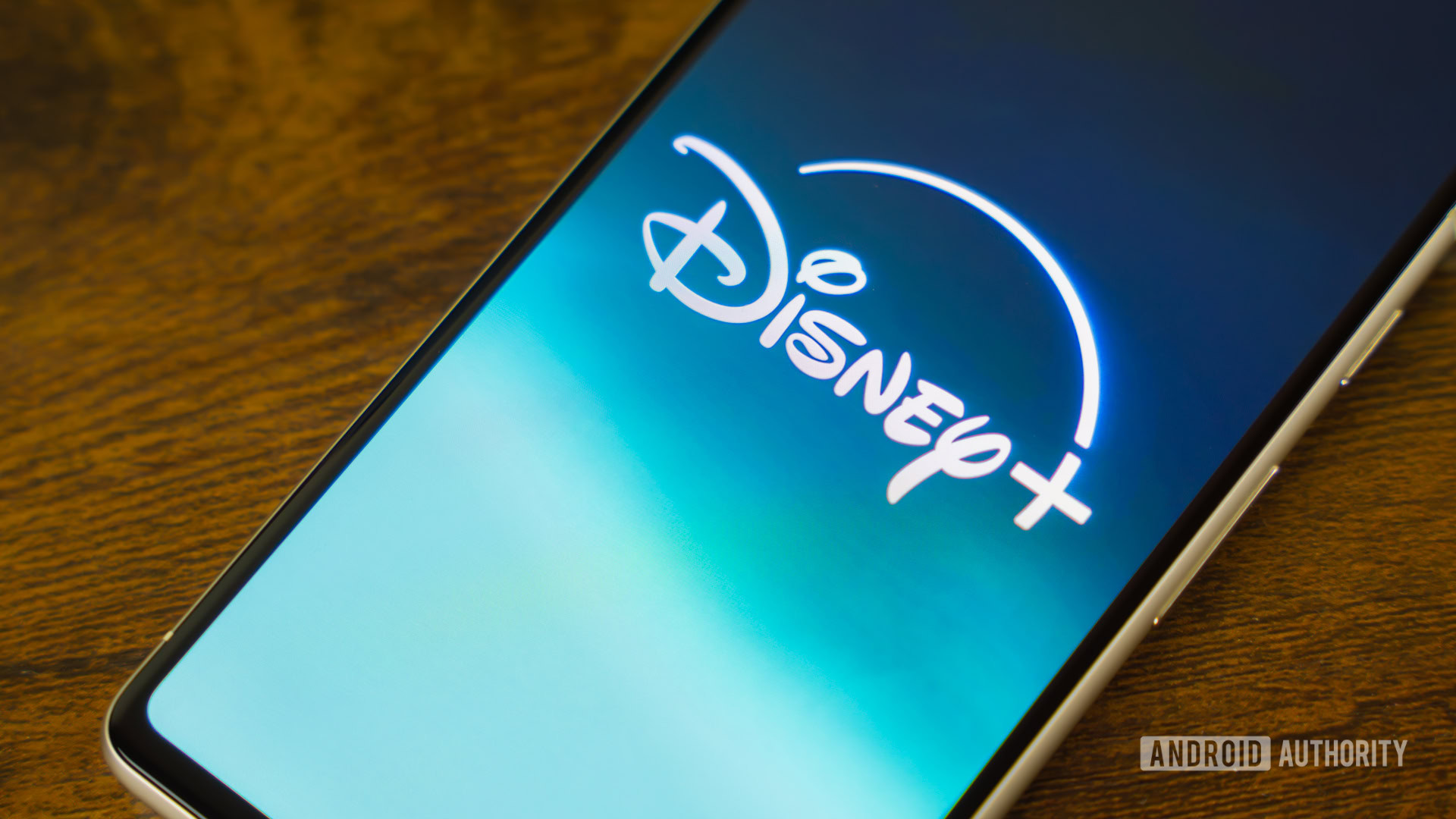




 English (US) ·
English (US) ·